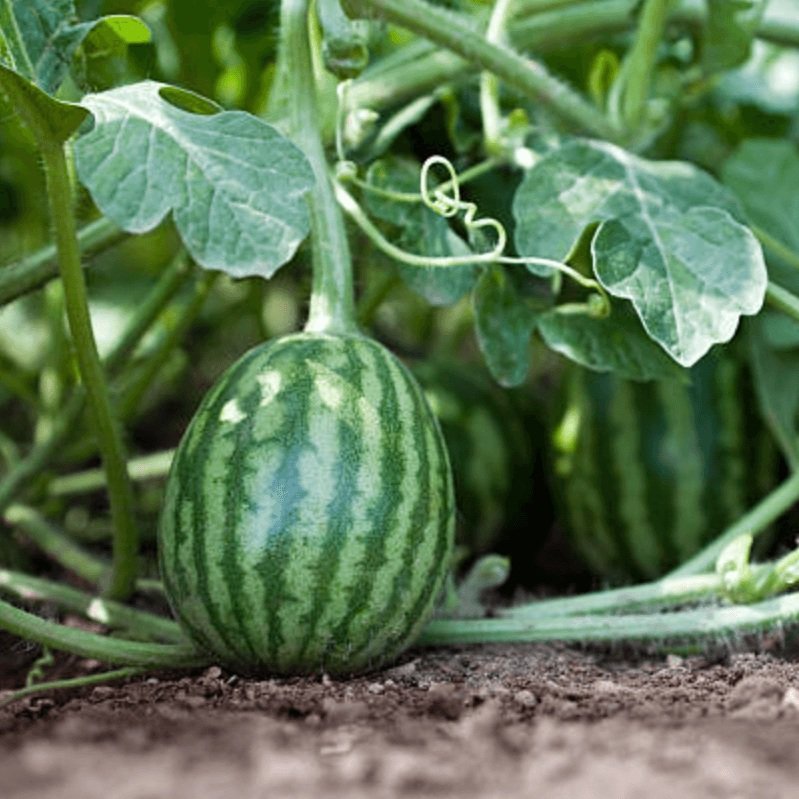Growing Watermelons From Seed
Background
This gardening guide will walk you through growing watermelons from seed. Citrullus Lanatus, most commonly called the watermelon is native to Africa, but has become a very popular fruit around the world. In this article you will be able to sucessfully care for a watermelon through harvest, with our expert tips and tricks.
Sunlight
Types of Watermelons
Watermelon plants thrive best in full direct sunlight for at least 6 to 8 hours per day. Place your plant in an area that has no trees or areas of shade. It may be in your best interest to invest in artificial light if you feel your watermelon plant is not fulfilling their daily sunlight needs.
-
A classic watermelon with a dark green rind and juicy, sweet red flesh.
-
A large, oblong watermelon with a green-striped rind and crisp, red flesh.
-
A small, round watermelon with a dark green rind and sweet, red flesh.
-
An oblong watermelon with a light green rind and juicy, sweet red flesh.
Humidity
Watermelon plants grow best in humid environments. Make sure that humidity levels are at least 50% at all times. If the climate is too dry, watermelon plants may shrivel or die completely. Invest in a humidifier that works outdoors if you feel your watermelon plant is not getting enough humidity.
Temperature
Watermelon plants are warm-season crops and require temperatures above 60°F (15°C) to germinate. They are typically grown in USDA hardiness zones 3 to 11.
Watering
Watermelon plants require consistent and adequate watering throughout the growing season. They should be watered deeply once or twice a week, depending on the climate and soil type.
Best Soil for Watermelons
Watermelon plants prefer well-draining, fertile soil with a pH range between 6.0 and 7.0. Adding compost or organic matter to the soil can improve its quality and nutrient content.
Starting From Seed
Choose a suitable location: Select a location with full sunlight exposure and well-draining soil. The soil should be rich in nutrients and have a pH range of 6.0 to 7.0.
Plant the seeds: Sow the seeds directly into the soil at a depth of 1 inch (2.5 cm) and a spacing of 2 to 3 feet (0.6 to 0.9 meters) apart. Alternatively, you can start the seeds indoors in pots or trays 3 to 4 weeks before the last frost date in your area and transplant them outside after the soil has warmed up.
Provide consistent watering: Water the soil immediately after planting the seeds and keep it moist but not waterlogged throughout the growing season. Watermelon plants require consistent and adequate watering to produce healthy fruits.
Provide support: Watermelon plants can grow quite large and heavy, so providing support can help prevent them from breaking or falling over. You can use stakes, trellises, or cages to support the plants as they grow.
Fertilize regularly: Watermelon plants require regular fertilization to provide them with the nutrients they need to produce healthy fruits. Use a balanced fertilizer or a fertilizer high in nitrogen during the vegetative stage and switch to a fertilizer high in phosphorus and potassium during the fruiting stage.
Companion Planting
Watermelon plants can benefit from companion planting with herbs like basil, oregano, and thyme, which can repel pests and attract pollinators.
Harvesting
Watermelon plants typically produce fruit within 70 to 90 days after planting. They are ready to harvest when the bottom of the fruit turns yellow or creamy white, and the stem begins to dry out.
Suceptible Pests & Diseases
Pests:
Diseases:
Downy mildew
Anthracnose
Bacterial wilt
Fusarium wilt
-
While watermelon is safe for human consumption, the seeds and rind can pose a choking hazard for pets. Additionally, the high sugar content of watermelon can cause gastrointestinal upset in dogs if consumed in large quantities.
-
Watermelon is a low-calorie, hydrating fruit that is rich in vitamins A and C, as well as antioxidants. It may also have anti-inflammatory and cardiovascular benefits.
If you or any other person has a medical concern, you should consult with your health care provider or seek other professional medical treatment immediately.
-
Watermelon plants typically take 70 to 90 days to produce fruit, depending on the variety and growing conditions.
-
Watermelon plants thrive in warm, humid climates with well-draining soil and plenty of sunlight. They can be grown in a variety of locations, including backyard gardens, raised beds, and containers.



